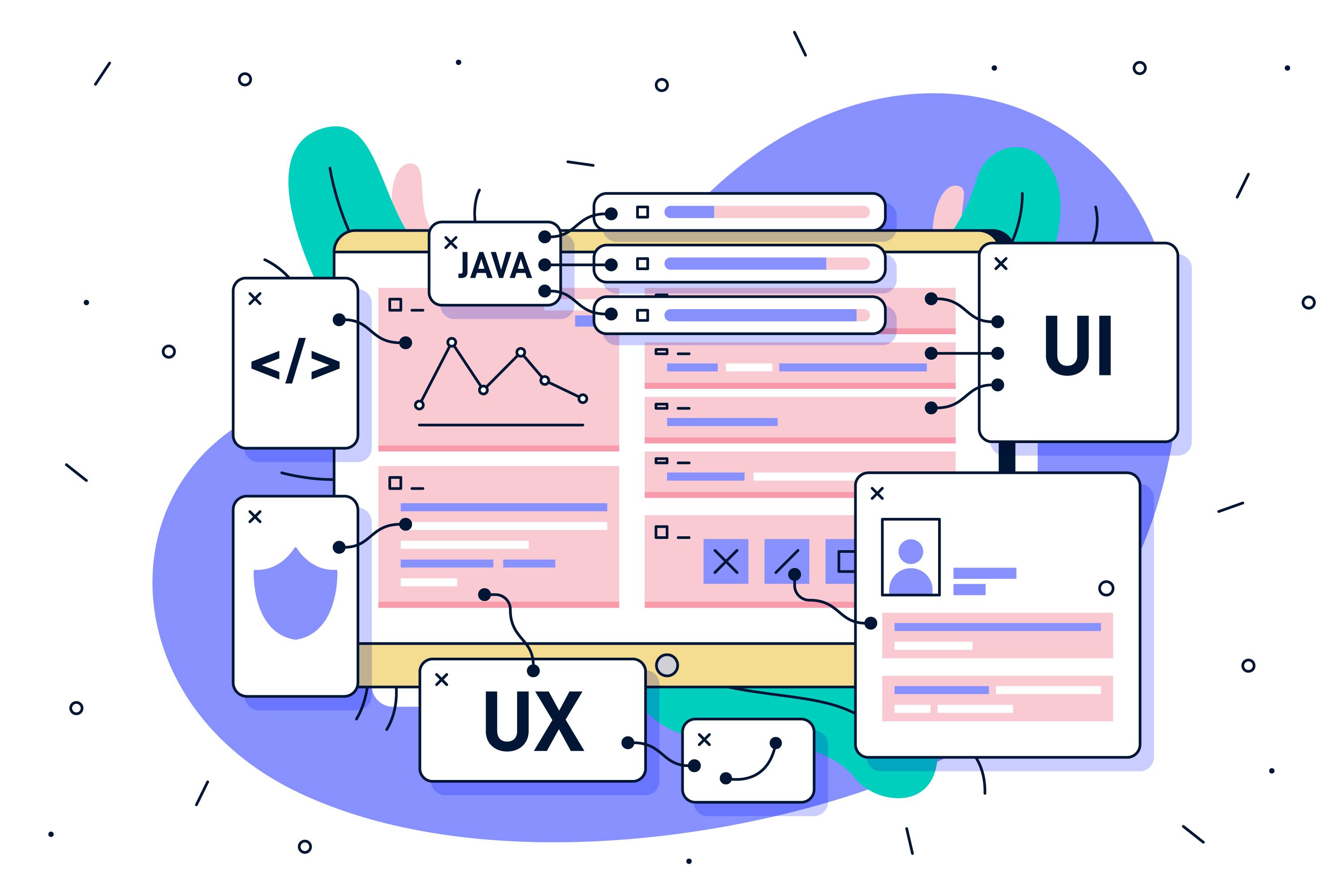Front-end development is the process of creating the part of a website or application that users see and interact with. This includes the layout, design, and front-end user interface elements like buttons, images, and menus.
A front-end web developer is responsible for making sure the website or app is visually appealing and easy to use. They build these interactive parts with front-end programming languages such as HTML, CSS, and JavaScript. Their tasks also include optimizing the website for different devices, helping it load quickly, and solving any visual or functional issues. A front-end developer's main goal is to create a smooth and enjoyable user experience.

Key Elements of Front-End Development
Front-end development is built on several essential parts, focusing on creating an engaging experience for users when they visit websites or apps.
A frontend language is at the heart of every website's look and feel, with HTML, CSS, and JavaScript leading as the main tools:
- HTML, or Hypertext Markup Language, is responsible for structuring content and giving it meaning. This language defines headings, paragraphs, images, and links, laying out the skeleton of the webpage.
- CSS, or Cascading Style Sheets, adds styling to this structure, making the site visually appealing by adding colors, fonts, layouts, and animations. CSS lets developers control the website's appearance, ensuring it fits the intended design.
- For many, front-end JavaScript is the best language for front-end development when it comes to creating interactive elements. JavaScript is a powerful programming language that brings life to the webpage, allowing users to interact through forms, animations, sliders, and dynamic content updates. As a front-end coding language, JavaScript is essential for building engaging, interactive features that respond to user actions. Libraries and frameworks like React, Angular, and Vue make JavaScript even more effective, helping developers create complex applications with ease.
In addition to these core front-end solutions, developers often use tools like preprocessors (for example, SASS for CSS) and bundlers (like Webpack) to simplify and optimize code. The goal is to build fast, responsive websites that work well on all devices. Front-end development combines creativity and technology, using various front-end coding languages to build web pages that are both attractive and functional. By carefully combining these tools and techniques, developers create sites and apps that provide a smooth experience for every user.
The Advantages of Front-End Web Development Services
Front-end development services are essential for creating websites that look good, load quickly, and are easy to use. With the right front-end technology, these services focus on making websites that help businesses stand out and connect with their audience.
The main benefits include:
- Better User Experience: Front-end developers work with front-end practices to build attractive, user-friendly sites. A clean, organized layout helps users feel comfortable, encourages them to explore, and keeps them engaged.
- Works Across All Devices: Front-end development makes sure websites look and function well on any device, including desktops, tablets, and phones. This flexibility allows users to access the site anywhere, providing a consistent experience.
- Faster Loading Times: Successful front-end development projects allow websites to load quickly. A faster site keeps visitors from leaving due to long load times, which also helps improve the site’s search engine ranking, attracting more traffic.
- Builds a Strong Brand Image: Front-end development allows businesses to show their brand style through visuals, colors, and layouts that match their identity. This gives users a clear sense of the brand’s personality and builds trust.
- Helps with SEO: Front-end development also includes SEO-friendly practices, meaning the site structure, code, and images are set up for better search visibility. This helps the site appear higher in search results, attracting more visitors.
- Adds Interactive Features: With front-end technology like JavaScript, front-end developers can add features like animations, sliders, and forms that respond to user actions. These interactive elements make the site more enjoyable and encourage users to engage.
- Easy to Update and Grow: Well-planned front-end development also makes it easier to update and expand the website in the future. This means a business can add new features or freshen up the design as it grows without needing to rebuild from scratch.
In summary, front-end web development services bring many benefits, from better user experience and device compatibility to strong brand presentation and SEO support.

Popular Frontend Development Frameworks
Frontend development frameworks help developers build websites and applications faster by providing pre-written code, organized tools, and ready-to-use components. A good web front-end framework offers structure and saves time, allowing developers to focus on creating great user experiences. Let’s look at and compare the best front-end frameworks that have become favorites for building modern web projects.
Vue.js
Vue.js, or Vue, is another web front-end framework that has gained popularity because it is easy to learn and use. Vue is designed to be flexible, making it a great option for both simple and complex projects. Developers can use it for single-page applications or integrate it into existing projects to add interactive elements. Vue is highly customizable, allowing developers to add only what they need, which keeps the framework lightweight and efficient. It has clear documentation and a supportive community, making it accessible to developers of all skill levels.
Angular
Angular, developed by Google, is a full-featured front-end framework with many built-in tools. It’s particularly popular for large-scale applications because it includes routing, form handling, and data management solutions, all in one framework. Angular uses TypeScript, a JavaScript extension that helps catch errors early in development. Known for its two-way data binding feature, Angular allows changes made in the user interface to automatically update the underlying data and vice versa, keeping the app in sync without additional coding. Though Angular has a steeper learning curve, it’s a powerful tool for developers working on complex projects.
React
React, created by Facebook, is a popular front-end framework known for its speed and simplicity. It uses a component-based approach, where each part of the user interface is broken down into small, reusable pieces called components. As of 2024, React.js continues to be one of the most popular web frameworks among software developers worldwide, with 39.5% of respondents reporting its use. Its flexibility makes it ideal for websites and applications that require frequent updates or dynamic data. One of the major strengths of React is its vast community, meaning there are plenty of resources, plugins, and support available for developers.
Svelte
Svelte is a newer front-end framework that offers a fresh approach to building web applications. Unlike other frameworks that rely on the browser to do a lot of work, Svelte compiles the code at build time, so the browser runs only simple JavaScript without extra framework layers. This makes Svelte applications fast and efficient. Svelte is known for its simplicity, as developers can write less code to achieve more functionality. It’s growing in popularity among developers who want a simple approach with less overhead.
Ember.js
Ember.js is a web front-end framework that’s well-suited for building ambitious applications. It includes a lot of ready-made structures and tools, so developers can start building immediately. Known for its "convention over configuration" philosophy, Ember provides a standard way to organize code, speeding up development for those familiar with its setup. It’s particularly popular among teams building long-term, scalable projects, as its strict structure helps keep the codebase organized. Though it’s not as flexible as some other frameworks, Ember’s stability and reliability make it a solid choice for large applications.
Backbone.js
Backbone.js is a lightweight front-end framework that provides a basic structure for web applications. It’s a minimalist tool compared to more feature-rich frameworks, focusing on providing just the essentials: models, views, and collections. This makes it ideal for developers who want flexibility and prefer to choose additional tools as needed. Backbone is often used with other libraries like Underscore.js and is suitable for projects that need a solid structure without too much overhead.
Foundation
Foundation is a web front-end framework focusing on responsive design, making it a popular choice for mobile-friendly sites. It offers a collection of front-end tools, including components for navigation, forms, and layouts, that adapt to different screen sizes. Foundation’s built-in features make it simple for developers to create modern, responsive designs that look good on any device. While not as popular as some other frameworks, it’s a valuable tool for developers focused on creating flexible, accessible designs.
Each front-end framework has its strengths, and the best front-end framework for a project depends on the project’s size, goals, and developer preferences. By understanding the unique features of these popular frameworks, developers can pick the one that best meets their needs and build web applications that users will love.

Front-End vs. Back-End: Key Difference
Front-end and back-end web development are two main parts of creating a website. Though they have different roles, they work together toward a single goal: providing a smooth, enjoyable experience for the user. Let’s look at the key differences between front-end and back-end development and how the front end interacts with the back end.
Front-End Development
Front-end development is all about the user interface—the parts of a website that users see and interact with directly. This includes everything from text and images to buttons, forms, and navigation menus. The front end is built using HTML, CSS, and JavaScript coding languages. These languages help define the look and feel of the site and add interactive features.
In essence, front-end developers focus on creating a visually appealing layout, organizing content, and making sure everything responds smoothly when a user clicks, scrolls, or types. Their role also includes making sure the site is responsive so it looks and works well on any device, whether it’s a desktop, tablet, or smartphone.

Back-End Development
While the front end is what users see, the back end is the engine behind it. The back-end service handles everything that makes a website work, such as storing data, processing actions, and responding to requests from the front end. Back-end developers use languages like Python, Ruby, Java, and PHP to create the server-side logic that powers the website’s functionality. This code runs on servers, databases, and APIs, which communicate with each other to manage data and perform complex operations.
The back end keeps the website running efficiently and securely. It is responsible for user authentication, data storage, and information processing. For example, when a user fills out a form or completes a purchase, the back end handles those requests, processes the data, and stores it safely.
In summary, while front-end and back-end web development focus on different areas, they are essential to the overall user experience. Front-end development brings the design and interactions to life, while the back end provides the logic and structure that make everything work smoothly behind the scenes. Working together, they create a complete and functional website that responds to user needs, helping to create a better online experience for everyone.
Contents
1. Key Elements of Front-End Development
2. The Advantages of Front-End Web Development Services
3. Popular Frontend Development Frameworks
4. Vue.js
5. Angular
6. React
7. Svelte
8. Ember.js
9. Backbone.js
10. Foundation
11. Front-End vs. Back-End: Key Difference
12. Front-End Development
13. Back-End Development
Back to the top
The answers to your questions
What is the difference between a front-end developer and a web developer?
A front-end developer builds the visible parts of a website, like buttons and menus, using languages like HTML, CSS, and JavaScript. A web developer can work on a website's front-end and back-end, handling everything that makes the site run.
What is a front-end software engineer?
A front-end software engineer designs and builds the user interface of websites or apps, guaranteeing that the site looks good and works well for users. They use languages like HTML, CSS, and JavaScript.
How long does it take to do a front-end alignment?
A front-end alignment refers to adjusting the car's wheels to ensure they are correctly aligned with each other. Depending on the vehicle and the shop's equipment, this process can take 30 minutes to an hour. The time can vary based on the specific needs of the car and any issues found during the alignment.
